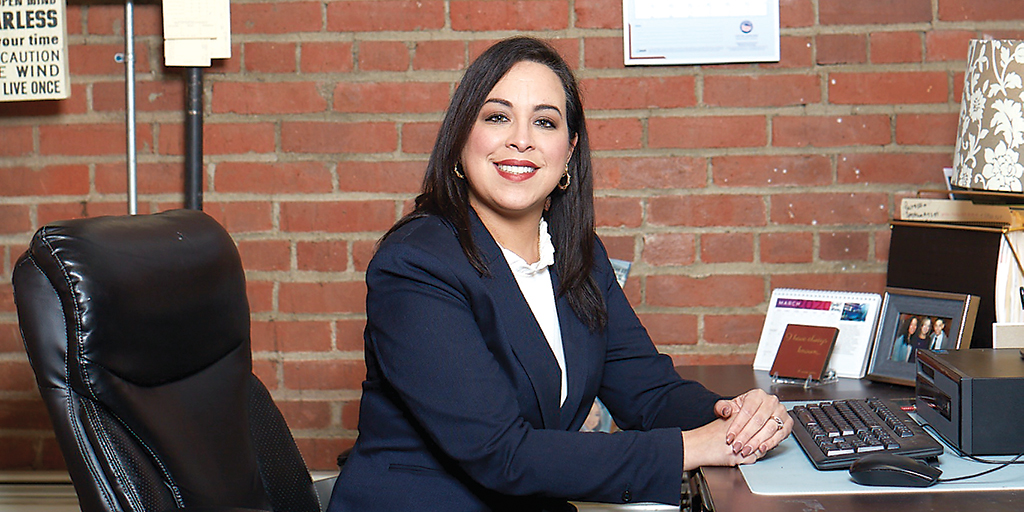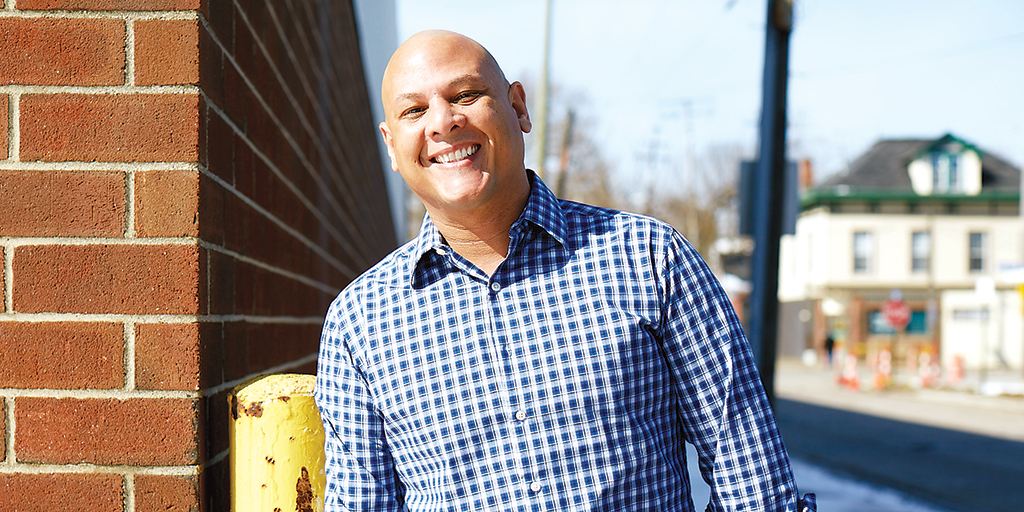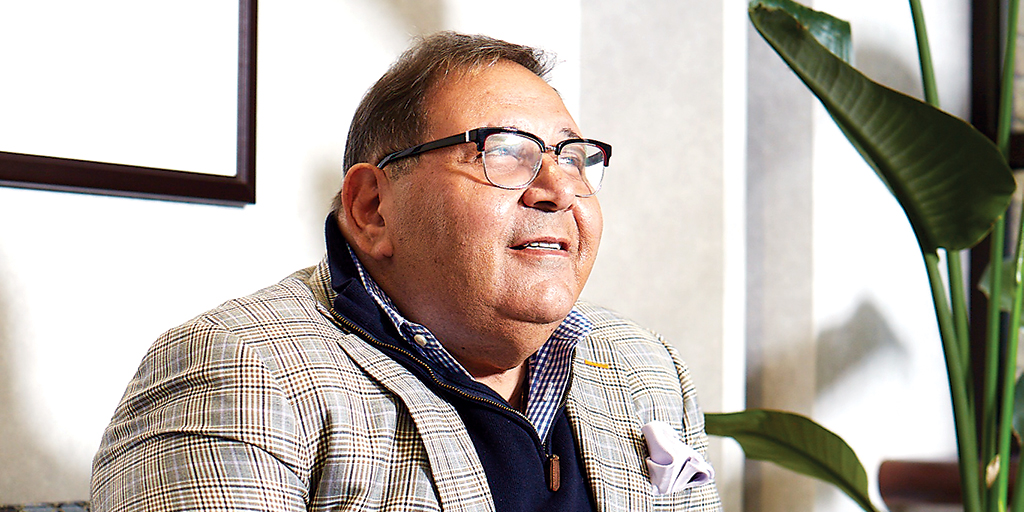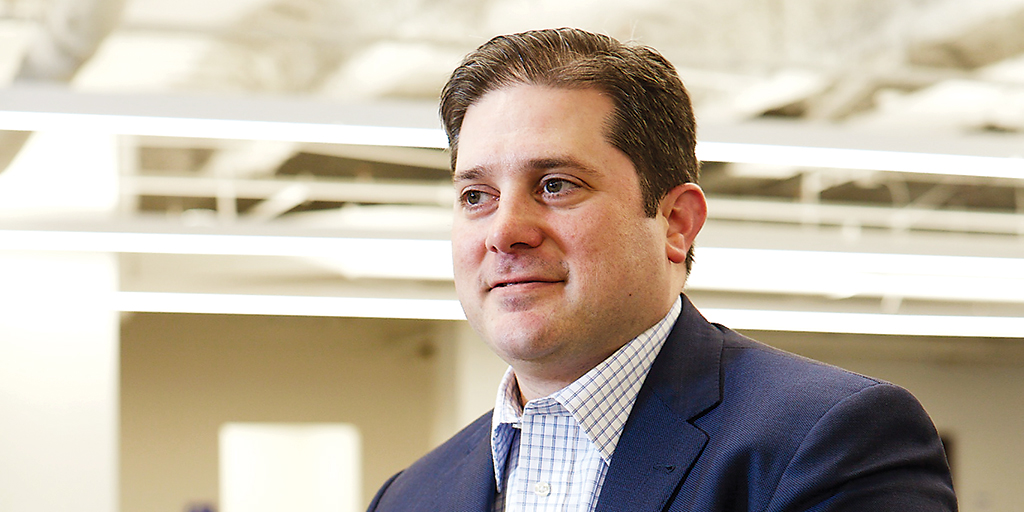MetroHealth System's Prescription For Hope
by Rebecca Meiser | Mar. 26, 2020 | 12:00 PM

COURTESY METROHEALTH
Editor’s Note: This feature story was reported in late February and early March, before the coronavirus, or COVID-19, outbreak upended the medical world and our daily lives. Due to our monthly print schedule, this article does not touch upon the hospital’s handling of the COVID-19 outbreak
Cleveland Councilwoman Jasmin Santana steps up to the microphone.
The 41-year-old, who oozes warmth but who also has the protective instincts of a mama bear, represents the Clark-Fulton neighborhood where the MetroHealth System campus resides. It’s a dense, largely Hispanic and Latino area just to the south of Ohio City and west of Tremont.
Santana knows the neighborhood has had its struggles over the years and it hasn’t always been well. Driving through it today, many houses are weathered; their frames sagging like the faces of old ladies. Some windows are covered with cardboard. Others barely have stairs.
Clark-Fulton lost half of its housing during the foreclosure crisis, 21% of the neighborhood remains uninsured and poverty rates are some of the highest in the city, with 47% living below the poverty line.
Yet despite their struggles, about 50 people have showed up on a Wednesday night in January at the Cleveland Public Library’s South Branch.
“What a great way to start out 2020,” says Santana, wearing a gray skirted suit, thick black patterned tights and silver hoops as large and glinting as her smile.

In 2014, MetroHealth, the county’s only public hospital, announced a $1 billion campus transformation plan which would include the removal of the hospital’s critical care pavilion and the construction of a new 11-story hospital tower in its place. MetroHealth served 300,000 patients in 2018, 74% of which were either uninsured, on Medicare or Medicaid. In June 2019, the hospital system announced that it would be investing $60 million in building 250 new units of affordable housing on its campus.
At its core, the community transformation plan considers all of Clark-Fulton and its surrounding communities as a single entity in need of care. The hospital is looking to improve the neighborhood’s health by investing in its economic opportunities, strengthening its affordable housing options, improving access to wellness programs and enhancing neighborhood spaces.
It’s a big proposal that will impact Santana’s constituents. With the densest Hispanic and Latino population in the state, there’s concern about losing the neighborhood’s cultural identity and fear of rising rent and gentrification.
To address anxiety, Santana encourages the audience to ask a lot of questions as Greg Zucca, director of economic and community transformation at MetroHealth, walks residents through a slideshow of photos and renderings that showcase the hospital’s new footprint. Staying within its current 52-acre campus, Zucca points out that the transformation will include 25 acres of green space, a Cuyahoga Community College access center and more. With the federal designation of the West 25th Street Corridor as an economic opportunity zone, new investments such as apartments and commercial businesses will be eligible for preferential tax treatment. It’s a model for how hospitals can positively impact the health of a neighborhood by directly addressing its concerns.
“If you want to have better outcomes, healthcare can’t just occur within the four walls of a hospital,” he says.
Zucca looks excitedly around the room for questions.
Slowly, they trickle forward. One woman, who lives a block away from MetroHealth, asks about potential street closures and traffic during construction over the next two years. Zucca assures everyone there will be lots of communication as progress develops. A man says he’s worried the proposed tax incentives will benefit those who live outside the neighborhood with deep pockets. What will happen if larger entities take over the neighborhood?
“We want to be diligent on what [jobs] we have here,” says Zucca.
He says MetroHealth and community partners are working on ways to create outside wealth creation opportunities for residents such as an economic opportunity center.
Then 49-year-old Kivin Bauzo raises his hand. Dressed in a yellow sweater as bold as his personality, he’s anxious to talk.
“I just want to applaud everyone here,” says Bauzo.
For 20 years, Bauzo has owned a house on West 33rd Street where he lived with his mom until she passed away three years ago. During that time, the foreclosure crisis hit and 11 other houses were abandoned on his block. He ultimately owed more on his house than it was worth. At night, he didn’t feel safe walking alone, and he was sick of the constant break-ins on the street. For years, he thought of bailing on his house and the community where he built his life. But what MetroHealth is offering seems to be much more than a Band-Aid. It’s attempting to revive a wounded community.
“Now, this is a place I actually want to stay,” he says. “It’s about freakin’ time we saw some movement.”


Cuyahoga County was unwell. When Akram Boutros took over as MetroHealth’s CEO in 2013, a community health status assessment for the county revealed hospitalizations for chronic conditions were 50% higher than the national average. One in four adults in the county were obese and older housing stock was contributing to elevated blood lead levels among children. In some areas of Cleveland, infant mortality rates were worse than in some developing nations. The prognosis seemed bleak.
“There is no city better than Cleveland to get stuff that’s already broken fixed, but we are terrible at preventing things from being broken,” says Boutros. “Since I wasn’t going to compete with the Cleveland Clinic and University Hospitals and their high tech, I had to focus on how to reduce things from breaking.”
So, Boutros started diagnosing the problems facing MetroHealth, beginning with the body of the hospital itself. MetroHealth’s critical-care facility towers were cramped. Patients had to share bathrooms, doctors couldn’t accommodate new technologies and there wasn’t room for visitors. Patient reviews left after staying in the rooms were consistently negative. And when visitors looked at MetroHealth from West 25th Street, all they saw was a big cement wall. The hospital was, in many ways, a failing body.
He then looked beyond the hospital, considering how a new MetroHealth could support Clark-Fulton. One of the most consistent complaints from neighborhood residents was the lack of parks. They had to trek five miles to Lakewood or Edgewater to find running paths and substantial green space. So it was decided to build a “hospital in the park.”
The new 11-story facility would be sleek, with floor-to-ceiling windows and private rooms with space for family members. But more importantly, nearly half of the 52-acre campus would be converted into green space with a connection to the Towpath Trail. Spending time in green spaces lowers blood pressure and stress levels, and the park was a much warmer welcoming mat than a cement wall.
By breaking down those physical barriers between the hospital and the neighborhood, Boutros hoped to make an impact on the vitality of the community.
“Few things do more for the body or the spirit than physical activity,” says Boutros. “Our neighborhood has so much to offer and so much cultural richness.”
Early on, in order to diagnose the plethora of problems wounding Clark-Fulton, Boutros needed to streamline the connection MetroHealth had with residents by holding a series of neighborhood meetings, talking with stakeholders such as the Metro West Community Development Organization and observing firsthand the issues in the community.
One of the most prevalent ailments existed in education. According to data from the Ohio Department of Education in 2016, Lincoln-West High School had only a 61% four-year high school graduation rate. But more than that, students were afraid to walk to school — just three blocks from MetroHealth’s campus — due in part to gang violence.
In 2016, Boutros opened Lincoln-West School of Science and Health with the goal of helping students get on track toward future employment. Today the school serves nearly 230 students, 66% of which come from the Clark-Fulton neighborhood. Those students get to shadow and eventually intern with MetroHealth professionals in fields as diverse as human resources, physical therapy and nursing. As of last spring, its first class of 20 seniors had all been accepted to college.
“We were going to offer [these students] a great change in their life, but at the same time, we were going to learn more from these kids about what is getting in their way of being healthy, than they were going to learn from us,” says Boutros.
Part of MetroHealth’s transformation plan takes those lessons learned into account, with a $60 million investment to create 250 new apartments, while another $3 million low-income tax grant from the state will build an additional 185 new units of affordable housing with the help of Metro West and the city of Cleveland. A 12,000-15,000-square-foot grocery store is also in the works to create more healthy food options for the community. MetroHealth’s police department will also be a presence in the area to increase a sense of safety.
“We know that lack of reliable access to affordable, nutritious food makes people sick and causes stress and anxiety,” says Boutros. “We see this play out in patients with diabetes, hypertension and other illnesses. Why not make sure people have produce, vegetables and whole grains instead of prescribing them pharmaceuticals?”
To provide a vital checkup on the community, the hospital’s new Institute of H.O.P.E. program, an abbreviation for Health, Opportunity, Partnership and Empowerment, will alleviate real on-the-ground issues by screening patients for things like access to housing, economic status and more. The staff will then use that data to better pinpoint and address patient needs and stem problems as they arise.

A large map detailing Cleveland’s wards hangs over Santana’s desk. In the top left corner, she’s scribbled in black marker: “I don’t develop communities. I develop people who develop communities.”
It’s a reminder that a building itself cannot save its people. Instead, true community development relies on investing in residents through things like education, mentoring and counseling. These are lessons Santana learned on her own.
“Growing up, it was always just, ‘Get a job; pay the rent.’ We were never encouraged to dream big,” she says.
As a child, she was crippled by self-doubt. Through the help of a supportive boss and an intrinsic belief that better things were possible, eventually her whole outlook changed. But she knows how hard it is to flip that narrative and mentality, from both her perspectives as a longtime Clark-Fulton resident and as a former employee of MetroHealth.
She spent the first part of her life in the Detroit Shoreway area, before she was forced to relocate to the Stockyard neighborhood when she was 14 due to gentrification. Her mother was slow to learn English after coming to Cleveland from Puerto Rico in 1966. She made a living by cleaning houses and selling homemade food such as pasteles, a tamale-like recipe made with bananas, beef and cheese, out of their kitchen. Santana played the role of translator for her mother.
“I was the person she relied on for doctor’s appointments, and to tell the landlord that she didn’t have the money yet, but she would soon,” she says.
Their family didn’t have a car, so they relied on public transportation and used community resources such as Ohio City’s May Dugan Center to provide items including clothing and counseling. There were times that Santana and her siblings ended up in women’s shelters. And MetroHealth, with its twin towers, loomed over everything like a walled fortress.
“I didn’t know anyone who worked there,” Santana says. “It was like this entire other city that was very hard to access.”
Santana entered through its gates for the first time in 2004, when her mom’s good friend Mildred was diagnosed with breast cancer. Santana soon understood why so many residents shied away from the hospital.
“There was no Spanish signage there, translation services were poor, it was hard to get an appointment and there was no explanation of insurance,” says Santana.
The experience inspired her to take up a community outreach position at MetroHealth in a new grassroots program called Amigas Unidas, or Friends United. The program had been formed after doctors noticed troubling numbers of late-stage breast cancer diagnoses in the Hispanic and Latina community. They thought bringing mammogram screenings into the community might help diagnose problems sooner.
Santana hosted health fairs and screened hundreds of women. And during her nearly 10 years on the job, Santana says she helped 20 women diagnose breast cancer at an early stage. But it wasn’t long before she realized that the problems ran deeper than just access to mammograms.
“These women had trauma,” she says. “They couldn’t afford their homes. They couldn’t find a job, day care, transportation — everything we talk about now.”
Making doctors’ appointments was a low priority until it was sometimes too late. All this trauma and stress was affecting their health. Santana remembers one patient had to leave her children at home while being treated and there had been no one to take them to school or feed them.
“They lived down the street from me,” says Santana. “Do you think I could drive by there and go home knowing these kids were at that house alone? No, I had to stop and take them to McDonalds.”
As one of the few MetroHealth employees who lived in the neighborhood at the time, she tried raising her concerns to hospital management, but she felt like her concerns went unacknowledged.
“I was the token Latina at the table,” says Santana. “I didn’t feel like they were listening to me.”
Even today MetroHealth is trying to counter this ideology that it’s not in sync with the Hispanic and Latino community that surrounds its campus. It’s perhaps the hospital’s biggest obstacle to overcome. Already, Clark-Fulton residents are getting letters from unscrupulous developers and outside investors threatening that MetroHealth will sweep in and take their homes. These entities are trying to purchase homes at much lower values than potential future prices.
“I think [residents] think MetroHealth has so much money that they’re going to come in wholesale and change the fabric of the whole community,” says Rodney Lowallen, president of the Jones Homes block club.
MetroHealth has sworn publicly in forums that it will not buy houses. It has also offered to meet with anyone who is worried. But Santana says it’s still causing some anxiety.
“There’s this fear that I’m going to be pushed out, that I’m not going to be able to fight this bigger fish,” says Santana. “We all know bigger fish eat little fish.”
To stem those fears, MetroHealth continues to reach out to residents and block clubs, holding a series of meetings in the neighborhood to get their input on everything from building design to community needs.
By partnering with Santana, the Metro West Community Development Organization, the Cleveland Foundation and the city of Cleveland, MetroHealth is helping to create a joint $280,000 master community plan for Clark-Fulton that will inform development in the community for the next 10 years, covering everything from housing to transportation.
“In the community development world, you typically don’t have an anchor institution, a philanthropic organization, a city and an elected official partnering together on a master plan,” says Ricardo Leon, executive director of Metro West Community Development Organization. “It helps residents in the community understand that this is really being developed for them by them. We’ve never had that.”
In the meantime, Santana launched her own women’s empowerment series to help lift up female members of her ward. Meeting once a week for nine months, the program’s goal is to give members personal and professional development skills on concepts such as self-care, how to get politically engaged and how the legislative process works.
“Our goal is to invest in people and give them tools,” she says.

Eduard Walker dreams of being a physical therapist.
He’s been dreaming of it ever since he injured his ankle during a baseball game in his native Puerto Rico when he was eight years old.
For a few hours every Friday, the 17-year-old shadows physical therapists at Lincoln-West School of Science and Technology. Walker doesn’t work directly with the patients; he folds towels and cleans the machines. But all the while, he’s watching the therapists at work, seeing how they interact with patients. As he scrubs the seat of a recumbent bike, for instance, he watches as his boss Barbara calmly coaches an older woman named Edna through arm reps.
“You’re doing great,” says Barbara.
On other days, Walker sits in classes hosted by a MetroHealth human resources personnel, listening as they describe what human resources looks for in applicants. He’s already spent hours practicing pitches to future employers.
Three years ago, Walker moved to the Clark-Fulton area from Puerto Rico with his mother, stepfather and younger sister to escape the after-effects of Hurricane Maria.
Most mornings, Eduard makes breakfast for the family in their Hyde Avenue apartment. His mother suffers from high blood pressure and fibromyalgia, a condition that causes her hands to go numb. As a result, she’s unable to work or do many family chores, so Walker helps fill in the holes and subsidize their expenses. After school, he works at Little Caesars, then he’s up until 11 p.m. doing homework. He also does the shopping for the family on the weekends.
“I get stressed a lot, either with issues at home or at work,” Walker says, “and it makes it hard to focus sometimes.”
But he can see how his hard work can pay off. Former classmates who’ve graduated from the same MetroHealth program are working for $15 an hour as valets while others are taking classes to become state-tested nursing aides, a position that currently needs filling at MetroHealth, which also pays for students’ classes and tests.
This month, when Walker turns 18 and is eligible to work at the hospital, he will submit an application to work in MetroHealth’s dining services. At $15 an hour, the MetroHealth job pays the decent living wage he needs in order to survive.
Having MetroHealth on his job history will lift him up in college and career applications. He’s already been accepted to Cuyahoga Community College and the University of Akron — largely, he says, because of the recommendations of his supervisors at MetroHealth.
The hope is that these many touches by MetroHealth will reverse some of the years of generational trauma and disconnection in the community — it’s a way to impact the younger demographic and provide a path to a brighter future.
“I believe this neighborhood will be a role model for other cities,” Walker says.

Red scaffolding juts into the February sky.
From the top floor of the new MetroHealth employee parking deck, a bird’s-eye view of the new hospital construction — and just beyond it, the swath of land where the new housing will be built — gives a glimpse into what MetroHealth and Clark-Fulton’s future might look like.
If this plan works, MetroHealth will succeed in not only rehabbing its old and outdated buildings, but revitalizing a community at the same time.
“Here’s the thing,” says Boutros, pointing out his window toward the area where more affordable housing units will be built. “The best thing that can happen is we’re successful and we become a model for other people to follow.”
It will take time to know if the plans are successful. Hospital construction is scheduled to be completed by 2022. The hospital system hopes that, after the transformation plan rollout is complete, the result will be a decrease in the number of in-patient visits as well the number of days patients stay in the hospital. But a specific target goal and ideas of what that success might look like are still beyond the horizon.
“We’re focusing on addressing social determinants of health and reaching people who would benefit from the services,” says MetroHealth vice president of communications Mike Tobin. “We don’t have a specific target at this point.”
The goal for the new housing project is to keep residents in the neighborhood, and MetroHealth is confident that the apartments will fill quickly. When the Lofts at Lion Mills — the first multifamily affordable living unit in the neighborhood in more than 15 years — came online in 2017, its 36 units of affordable housing were fully leased within days.
“Our market data has shown that there is a pent-up demand for affordable housing,” says Zucca.

If the plan works, residents like Bauzo can ride bikes through the trails of MetroHealth’s newly opened park and shop at the new grocery store, where students from Lincoln-West can work part-time as a bagger for $15 an hour. Bauzo’s housing values might revert back to where they were pre-foreclosure crisis, and friends in the neighborhood will hopefully choose to stay in their homes rather than move to Old Brooklyn.
But is it enough for Clark-Fulton to bounce back?
Models similar to MetroHealth elsewhere have only been marginally successful. In the late ‘90s and early ‘00s, Bon Secours hospital in Baltimore built 800 units of affordable housing and converted more than 640 vacant lots in their neighborhood into green spaces. According to a 2018 case study by ChangeLab Solutions, this prevented 200 evictions and connected more than 400 people to public resources by offering eviction counseling in 2017. But although there was a decrease in the number of babies born with low birth weight, infant mortality and rates of sexually transmitted diseases between 2007 and 2017, the neighborhood poverty rate is still nearly 50%.
“It’s clear,” the authors of the report wrote, “that while major strides have been made, the residents’ needs continue to outstrip the scale of the hospital and its partner’s substantial resources.”
Even closer to home in Columbus, Nationwide Children’s Hospital invested more than $23 million into upgrading more than 300 houses in its neighborhood in 2008. Although the number of murders in the neighborhood have gone down dramatically and graduation rates have gone up, raising housing values resulted in some of the most at-risk residents for health issues being pushed out of the neighborhood.
Despite those challenges, MetroHealth is still trying to be more expansive in becoming a community catalyst for health and wellness. Boutros is optimistic about its audacious plan and its potential ripple effects on the community at large.
“We are not perfect,” Boutros says. “We are absolutely going to make lots of mistakes. But our intentions are noble. They are not about keeping this community down. It’s about lifting everyone up.”
The only thing that has ever driven people to make strides — in everything from public health to medicine — is hope, and that, he says, is what MetroHealth is in the business of providing today.
“What’s the alternative?” he asks.
For more updates about Cleveland, sign up for our Cleveland Magazine Daily newsletter, delivered to your inbox six times a week.
Cleveland Magazine is also available in print, publishing 12 times a year with immersive features, helpful guides and beautiful photography and design.
Trending
-
1
-
2
-
3
-
4
-
5










